
Harrow and Hillingdon Geological Society
Minerals and the Countryside
Home | Monthly Meetings | Field Trips | Exhibitions | Other Activities | Members Pages | Useful Links
Minerals and the countryside
Dr Brian Marker OBE
‘Minerals are essential for the economy and society but extraction, which mainly takes place in the open countryside, is a destructive process. New applications are usually strongly opposed by the public. But the impacts of extraction can be greatly reduced through good location, design and management of sites and restoration of land can bring benefits for the environment and communities. We will look at approaches to getting the minerals that we need while minimising adverse effects and making the best subsequent uses of worked land.’
Minerals can be defined as compounds with a fixed structure and properties from which rocks are formed but this presentation was about economic minerals, which can be minerals in the strict sense or rocks. It covered:
- What do we use minerals for?
- Where do we get them from?
- Regulation covering mineral activities,
- Rehabilitation of mineral workings ; and
- Good practices.
What do we use minerals for?
Construction
Most building materials are mineral products, used for road pavements, foundations, coastal defence and for construction of buildings. They are very important in the UK, with production of construction minerals totalling about 173 million tonnes per annum, a large part of which is aggregates – sand and gravel and crushed rock. Others include cement minerals, bricks, pipes and tiles, plasterboard, roofing slate and building stone.
Manufacturing
Minerals are used in manufacturing almost everything, from paper to paint, new technology and household goods.
Agriculture and horticulture
Fertilisers and pesticides are generally mineral-based and peat used to be an essential element in compost. Manufacturing and agricultural minerals total about 19 million tonnes per annum but they are essential for value-added products.
Energy
Coal, oil and gas and uranium are used for power generation. Production totals about 19 million tonnes per annum from onshore UK with imports of 161 million tonnes per annum, including UK offshore production.
Where do we get minerals from?
On land it is necessary first to find the minerals using drilling and trial pitting supplemented by geophysical techniques, to estimate quantities and qualities, and factors that influence extraction thickness of overburden above the mineral and geological structures.
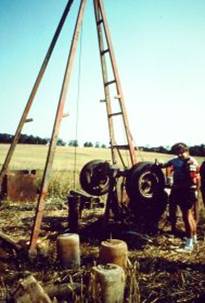
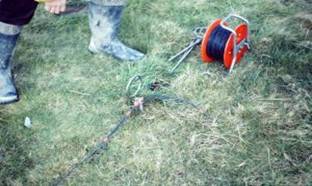
Shallow shell and auger drilling Resistivity survey
Opening the site involves scraping off the topsoil and storing it in marginal mounds (to screen the site from view), building the plant and securing access. Footpaths and hedges have to be dealt with.
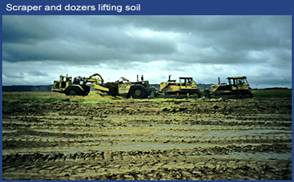
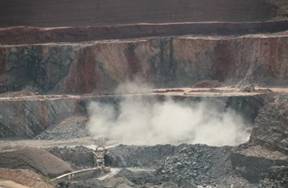
Scrapers and dozers lifting soil Blasting of hard rock for aggregate
(Courtesy of the Mineral Industry Research Organisation) (Courtesy of the Mineral Products Association)
Excavating the mineral can involve drilling and blasting for hard rocks, the use of excavators for softer material and wire cutting may be used for building stone.
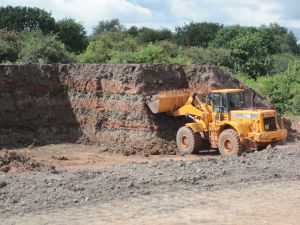
Digging brick clay
(Courtesy of the British Ceramics Confederation)
The mineral then has to be transported to the processing plant using direct transport by excavators, loading trucks for haulage or conveyors. Primary processing can involve crushing for rocks, crushing and screening or cutting building stone.
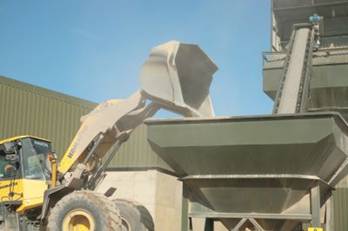
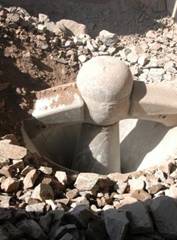
Feeding material taken from the face into the processing plant Primary crusher
(Courtesy of the Minerals Products Association) (Courtesy of the Mineral Products Association)
Value is added by using the mineral as coated stone, manufacturing bricks, pipes and tiles and cement works. These processes are of variable scale, but brick manufacture requires large factories and cement works very large factories with enormous capital investment, which needs long-term and consistent materials supply.
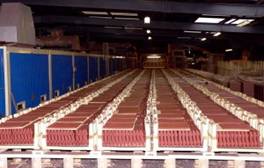
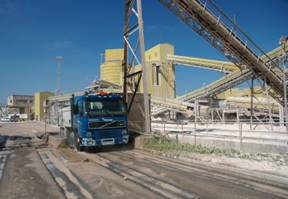
Roofing tile manufacture Loading for delivery by road
(Courtesy of the British Ceramics Confederation) (Courtesy of the Mineral Products Association)
Delivery to users is by road, rail, sea or barge. Most deliveries are over short distances, rail transport is restricted by the network, both the existence of lines and their availability. Marine transport only goes into ports. With rail or sea transport, final delivery to the market is still by road.
Problems arising from minerals extraction
These can include landscape and visual intrusion, noise and vibration, dust, traffic, effects on the water environment and waste.
While geologists may like to see quarries, many people do not and extraction is planned to reduce sight lines into the quarry, as well as using topsoil mounds to screen the site. However, very old quarries can look like natural dale sides.
Blasting must be properly designed to reduce vibrations and noise. Ancillary breakage can be a problem, as can noise from plant. It is reduced by enclosing plant as much as practicable and the use of screening bunds and careful siting.
Dust arises from blasting and other processes, especially transport around the quarry and can cause problems to residents and to workers. It can be reduced by hosing operations in buildings, trapping drilling dust, the use of water bowsers on quarry roads and stockpiles and sheeting lorries which leave the site.
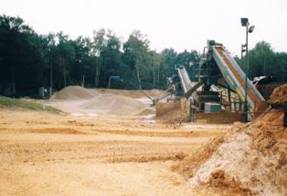
Plant and machinery give rise to noise
(Courtesy of the Mineral Products Association)

Vegetation coated with dust near a limestone quarry
(Courtesy of the Mineral Products Association)
Traffic is a big issue, particularly on narrow country lanes. It is essential to ensure good quality site access onto a suitable road.
The water environment is affected by excavating below the water table, when pumping causes local drawdown. Water used in processing has a high sediment load and is disposed to settling ponds, which flow slowly over a weir to minimise sediment load. Some silica sand production requires acid to strip the iron coatings from the grains and treatment of this water is required before disposal.

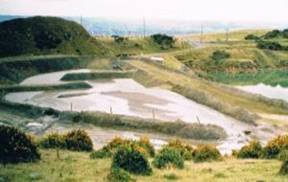
Controlled outflow from a settling pond Tip and tailings lagoon at a china clay pit
Quarry owners do not think of unsold material as waste because they never know when they might be able to sell it. Some material may not be immediately saleable because it does not meet customers’ specifications and has to be stored. In many cases, it cannot be returned immediately to the quarry because access is required to further mineral reserves. China clay extraction, for example, produces large amounts of unsuitable material which cannot be returned to the pit until the operation is over. Open cast coal extraction digs overburden and material interbedded with coal seams but this can generally be returned to the void fairly quickly. Sometimes waste can be deposited in the worked out area of a pit.
Stability of faces and tips can be a problem and careful planning and design is required as well as operations to dress faces to remove unstable blocks and controlling the height of the face by benching.
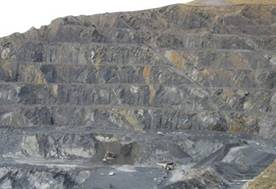
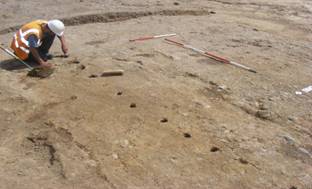
Benching at a hard rock quarry Excavation prior to mineral extraction
(Courtesy of the Mineral Products Association) (Courtesy of the Mineral Products Association)
Effects on the cultural heritage can be a two-edged sword, since quarrying destroys archaeological remains but it can also expose unknown material which can be studied before extraction continues.
The scale of operations can make a difference to its acceptability, eg the contrast between a large limestone quarry extracting 5-10 million tonnes per annum, a small building stone quarry extracting a few hundred tonnes per annum or a delve (basically a temporary disturbance of the top metre or so to extract roofing materials). Planning policies and conditions should reflect the scale and impacts of the operation rather than being “one size for all”
What are the regulations covering mineral working from the land
Planning
This includes planning policy with minerals planning authorities issuing minerals development documents, which are subject to sustainability appraisal, consultation and public examination. Planning applications are subject to environmental impact assessment, consultation and public local inquiry. Consents invariably have multiple conditions to control the effects of working with enforcement by mineral planning authorities. Old permissions are subject to review to ensure that conditions are up-to-date. However, the entire planning system is being revised with much being left to local authorities rather than issuing central guidance from government.
Factors considered by mineral planning authorities include wildlife, amenity, heritage, proximity, access and implications for transport as well as the impacts, mitigation proposals and hours of working.
Environmental permits
Environmental permits cover emissions to air, water and soil, safety and inspection of tips and lagoons. The aim is to minimise or offset any adverse effects. Regulation and enforcement is by the Environment Agency. Where there is potential conflict between planning and environmental permits, the latter take precedence so planning conditions can be more onerous than the environmental permit but never less.
Health and safety
Regulation covers the health and safety of workers, visitors and trespassers and is enforced by the Mines and Quarries Inspectorate of the Health and Safety Executive.
Minerals from the sea
Sand and gravel and oil and gas are obtained offshore but they still have to be landed and carried t the market. It is too simplistic to suggest we should get more from the sea to replace quarries on land because transport costs mean we still need inland quarries to supply inland areas. The sea is also important form the biodiversity and marine conservation viewpoint so there are limits.

Sand and gravel dredger
(Courtesy of the British Marine Aggregate Producers Association)
Imports
We already import lots of minerals and depend on the rest of the world for these. The main reasons are geological in that economic reserves of a particular mineral may not be present in the UK, the price may not be high enough to make UK resources economical and costs of labour and extraction are high in the UK. It is not easy to reduce the damaging effect on our environment by turning to imports because overseas extraction damages other people’s environment and regulation and its enforcement are often not to the standard we would accept.
Currently about 47% of our mineral usage is imported, including about 3% of construction minerals, 51% of industrial and agricultural minerals and 89% of energy minerals (including offshore oil and gas.
Alternatives
Re-use, recovery and recycling have been well developed in the UK, particularly for cans, glass and construction and demolition waste and we are progressing with plastics. About 25% of annual aggregates usage is from recycling.
Rehabilitation
Natural regeneration is often the best form, as in the examples of the apparently natural daleside in Derbyshire or the Blue Pool in Dorset, but, in most cases, planning authorities and the public are not willing to wait for decades until that has taken place. Active rehabilitation, either during extraction or after operations have ceased, can include re-vegetating the floor of the quarry, infilling the site with waste or with landfill. Quarries can be returned to use for agriculture, forestry, buildings and water uses, such as the Eton Dornay rowing centre being used for the Olympics.
Rehabilitation also has to consider biodiversity, with the natural cycle in Britain being to a forest climax community and much of our biodiversity has been achieved through human activity and needs to be managed.
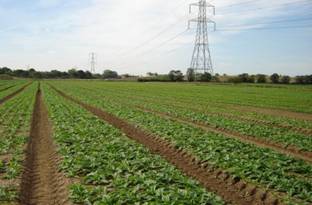
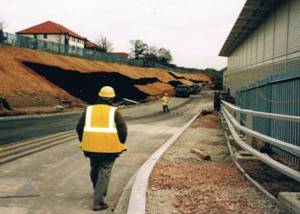
Restoration of gravel pit to agriculture Restoration of a site for industry
(Courtesy of the Brett Group)

Restoration of a gravel pit to wetland habitat
(Courtesy of Cemex UK)
Geodiversity and the preservation of geological exposures are also important, as is the preservation of mining and quarrying heritage.
Good practices
A lot of the bad reputation of quarrying was because no-one knew what was going on. The industry now actively interfaces with people, with viewing platforms, visits to quarries, liaison committees, leaflets and the general provision of information.
Sustainability needs reserves to be safeguarded and as far as possible meeting our own requirements with minimal impacts, constructive restoration and after-use and reducing extraction through re-use and recycling where it is environmentally beneficial.